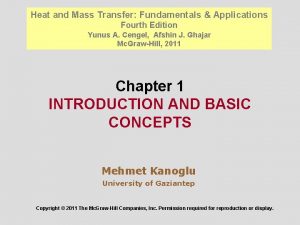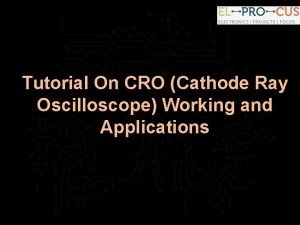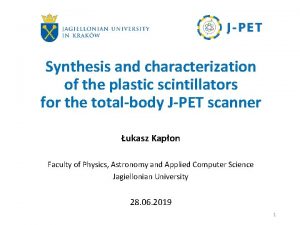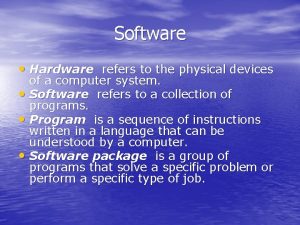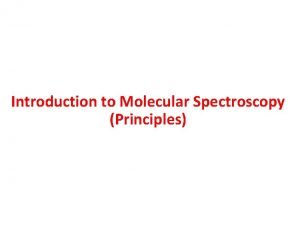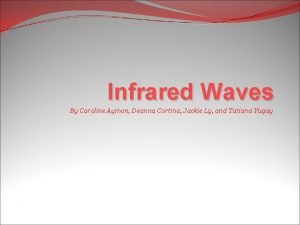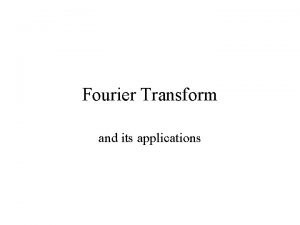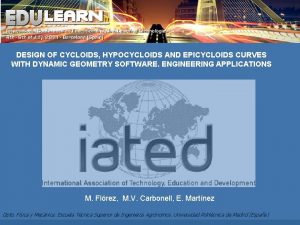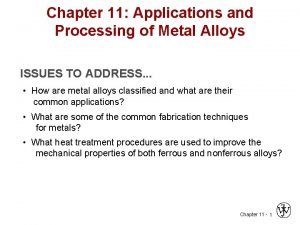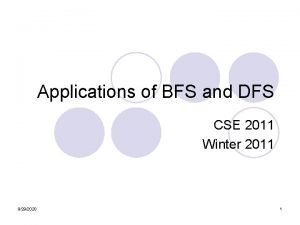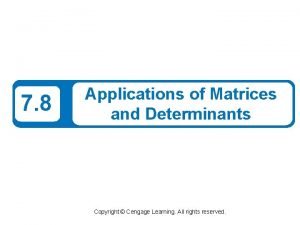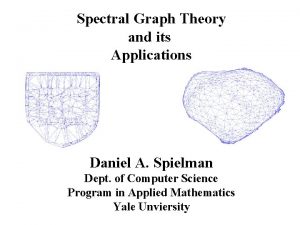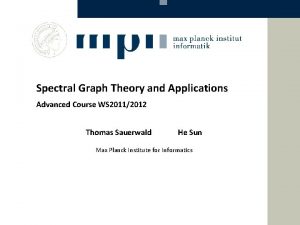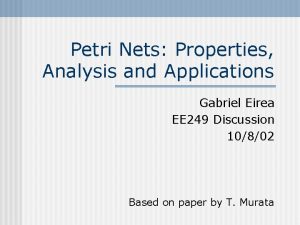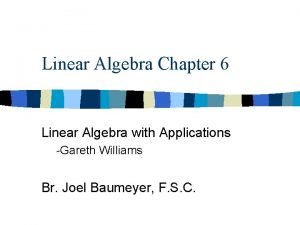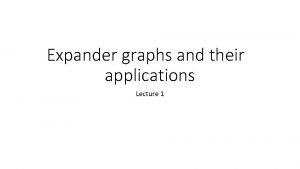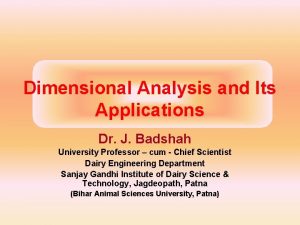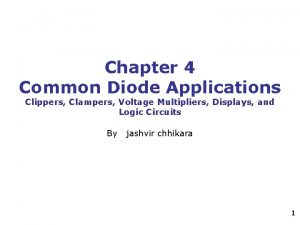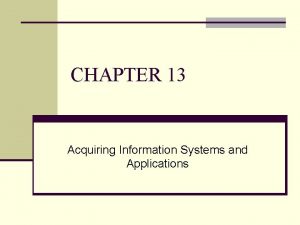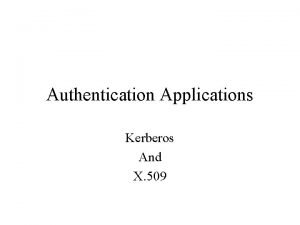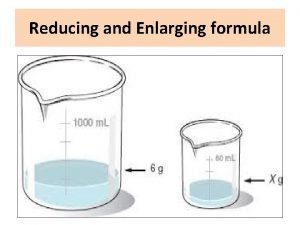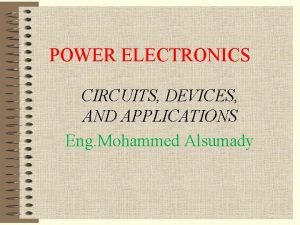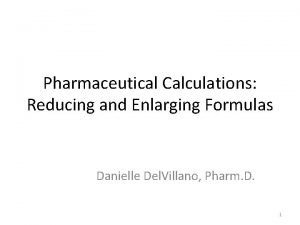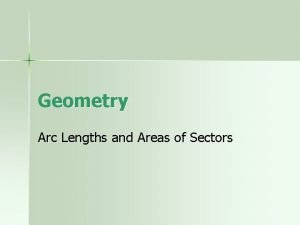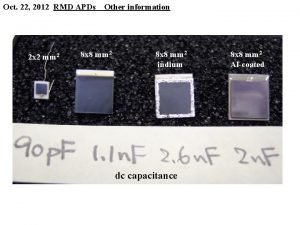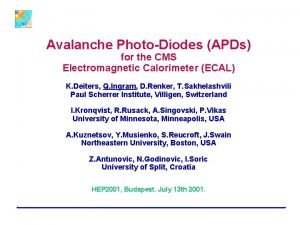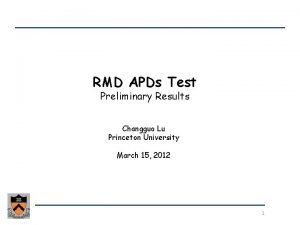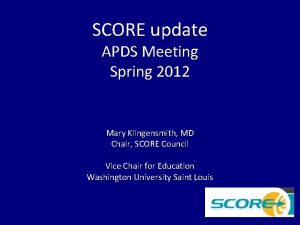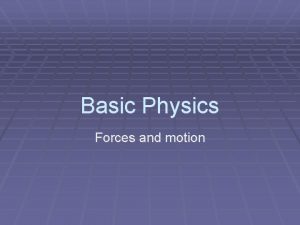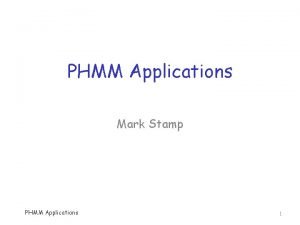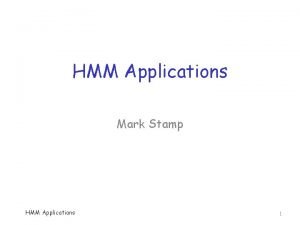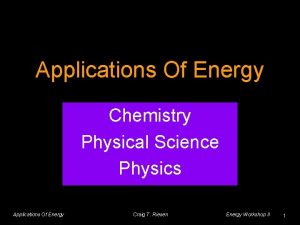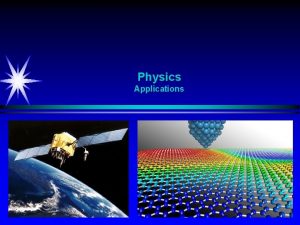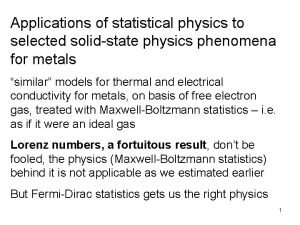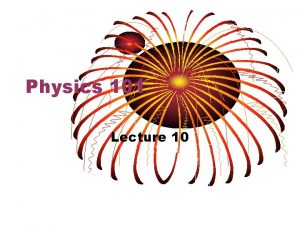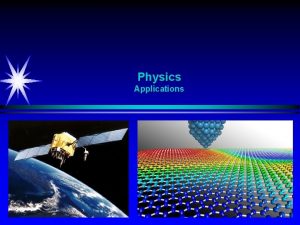Physics and applications of Hg Cd Te APDs

















































- Slides: 49

Physics and applications of Hg. Cd. Te APDs Ian Baker (SELEX) and Johan Rothman (CEA LETI) 09/10/2013

Outline Amplified photodetection Hg. Cd. Te APDs physics and limitations Hg. Cd. Te APD applications with arrays (imagery) and single pixel detectors § Summary/perspectives § § Physics and applications of Hg. Cd. Te APDs, Baker and Rothman 9. 10/2013 |2 © CEA. All rights reserved

Amplified photodetection Physics and applications of Hg. Cd. Te APDs, Baker and Rothman 9. 10/2013 |3 © CEA. All rights reserved

Photodetection without internal gain Photon signal Readout noise s. RO Measured signal Physics and applications of Hg. Cd. Te APDs, Baker and Rothman 9. 10/2013 |4 © CEA. All rights reserved

Photodetection with gain M M x Photon signal Internal photodetector gain M RO noise M Measured signal The gain extracts the signal from the read-out nosie: Low signals and/or high read-out noise : 0. 001 - 10 000 photons per observation time Physics and applications of Hg. Cd. Te APDs, Baker and Rothman 9. 10/2013 |5 © CEA. All rights reserved

Photodetector gain PD gain § Amplifies the signal to avoid SNR degradation due to the noise in the read-out electronics § Avoid loosing information … at best: P(M) s. M <M> Excess noise factor M Information conservation FM Physics and applications of Hg. Cd. Te APDs, Baker and Rothman 9. 10/2013 |6 © CEA. All rights reserved

Mx. Signal+ Read out noise (Noise floor) Avalanche gain with low excess noise 100 m. V Signal x QE Signal (100 photons) 10 m. V H Lo igh w F F Amplified SNR 1 m. V Output voltage 100µV ~Photon SNR Photon noise (10 x√QE) Variance in gain multiplies photon noise x√F (F=APD excess Noise Factor) Electronic noise floor (FN) 10µV Dark current noise 1µV Increasing Gain The object of avalanche gain is to increase the signal and photon noise above the fixed noise of the system QEFR=QE/F should be maximal Dark current noise should be minimal Physics and applications of Hg. Cd. Te APDs, Baker and Rothman 9. 10/2013 |7 © CEA. All rights reserved

Hg. Cd. Te avalanche photodiodes - Typical gain curve - Gain Probability Distribution Function (PDF) and excess noise factor - Gain physics (geometry, lc, temperature) - Dark current limitations - Response time measurements Physics and applications of Hg. Cd. Te APDs, Baker and Rothman 9. 10/2013 |8 © CEA. All rights reserved

Multiplication gain M Hg. Cd. Te Avalanche photodiodes (APDs) Signature of multiplication without avalanche breakdown: Single carrier multiplication: SCM !!! Reverse bias (V) § Avalanche gain M>1000 to detect light from uv to the IR cut-off wavelength § Low excess noise factor F=1. 1 -1. 3 (DRS, Selex, BAE, Raytheon, CEA) § Information conservation record : QEFR ~60 -90 % § QEFR < 0. 5 for all other amplified detectors (PM, Si/II-V APDs, EMCCD. . ) ! § Potentially the best detector for low photon detection and photon counting ? Physics and applications of Hg. Cd. Te APDs, Baker and Rothman 9. 10/2013 |9 © CEA. All rights reserved

Multiplication gain distribution estimated from single photon detection (CEA-LETI) APD hybridised on a low noise ROIC Noise/TC = 10 -20 elect. BW= 7 MHz Cold filter Residual thermal flux detected with MWIR APD 4. 6 µm) Single photon events 1. 6 MHz (Ires=230 f. A) ADV=0 (flux zéro) Dark events amp (V) DCR=20 -300 k. Hz Seuil de <M> à 0. 25 <M> (DCR SWIR << 10 k. Hz) time (µs) Physics and applications of Hg. Cd. Te APDs, Baker and Rothman 9. 10/2013 | 10 © CEA. All rights reserved

Gain probability density function (PDF) of MWIR CEA-LETI Hg. Cd. Te APD at 80 K <M>=368 =1. 25 § Direct estimation of F= 1. 25 § The observed distribution enables high photon detection efficiency and the possibility to make photon number resolved (PNR) detection § PDE=90 % at 0. 5 x<M> § At the limit of PNR which is not possible with F>1. 3 (F>=2 EMCCDs, SI/III-V APDs) Physics and applications of Hg. Cd. Te APDs, Baker and Rothman 9. 10/2013 | 11 © CEA. All rights reserved

Linear mode photon counting with a CEALETI Hg. Cd. Te APD Measured Distributed dark-current generation Measured 1 photon APD gain PDF (+dark counts > 6 m. V) DCR=20 -300 k. Hz Seuil de <M> à 0. 25 <M> § Distributed dark current generation § Discrimination of non-amplified dark current events Lower DCR § Low noise on the amplified dark current Noise on the dark current is the limiting parameter Physics and applications of Hg. Cd. Te APDs, Baker and Rothman 9. 10/2013 | 12 © CEA. All rights reserved

Avalanche gain in Hg. Cd. Te – illustration of single carrier (electron) history dependent impact ionisation Foundations for MCT APD technology Absorption of photons must be on the P-side to generate electrons for full benefit of avalanche gain. hv Above a depletion width of 2. 5 -3. 0µm 1, 2 alloy and phonon scattering starts to impact ionisation threshold voltage. Below approximately 1. 0 to 1. 5µm there is risk of gain saturation and tunnelling currents. 1. 5 -2. 5µm is technologically convenient Electron and hole velocities limits the response time Potential energy Low F due to spatially ordered multiplication Heavy hole mass – 0. 55 m 0 - low mobility Holes must migrate to P-region to complete signal but otherwise do not take part in avalanche process hence low noise figure in Hg. Cd. Te Recent literature 1 Johan Rothman, Laurent Mollard, Sylain Gout et al, “History-Dependent Impact Ionisation Theory Applied to Hg. Cd. Te e-APDs”, Jn of Elec Mat, Vol 40, No 8, 2011 2 Mike Kinch and Ian Baker, “Hg. Cd. Te Electron Avalanche Photodiodes”, Chapter 21, Mercury Cadmium Telluride - Growth, Properties and Applications, published by Wiley Physics and applications of Hg. Cd. Te APDs, Baker and Rothman 9. 10/2013 | 13 © CEA. All rights reserved

Influence of junction geometry on gain and noise Front side illuminated APDs with lc=4. 6 µm at T=80 K Planar N+n-P diodes in EPL and MBE grown epitaxies N+ <w. C> n-~1014 cm-3 P~ 1016 Gain in CEA- APDs with different <wc> Tunnel currents wc=1. 4 µm wc=0. 8 µm cm-3 wc=2. 4 µm § The gain is correlated with the average junction extension § Increased threshold voltage, ~ constant slope § Gain variation have been modeled as a function of x. Cd and T* § The excess noise has been found increases with increasing junction width § Junction geometry fluctuations and enhanced uncertainty on the gain ? *Rothman et al, JEM 41, 2928 (2012) Physics and applications of Hg. Cd. Te APDs, Baker and Rothman 9. 10/2013 | 14 © CEA. All rights reserved

Gain as a function of lc at T=80 K CEA-Leti APDs § The gain decreases with decreasing lc § Exclusive electron multiplication with low F have been demonstrated down to lc= 2. 2 µm (M=20 at 20 V) § Limits the lowest possible dark current § The behavior of lower lc APDs is still not clear § Onset of hole multiplication will strongly increase F and kill the particularity of Hg. Cd. Te APDs ! Physics and applications of Hg. Cd. Te APDs, Baker and Rothman 9. 10/2013 | 15 © CEA. All rights reserved

Variation of the gain as a function of temperature (lc=3. 3 µm at T= 80 K) 200 K 220 K 180 K 273 K 293 K § The gain decreases as a function of temperature § Local gain model variation of the band gap and increased (low) energy dispersion * *Rothman et al, JEM 41, 2928 (2012) Physics and applications of Hg. Cd. Te APDs, Baker and Rothman 9. 10/2013 | 16 © CEA. All rights reserved

Dark currents in Hg. Cd. Te APDs Ieq_in @ 80 K Ieq_in (Mdark< M) p i n Ieq_in (p. A) DC generation § Ieq_in decreases lc at constant gain and temperature § Dark current of 10 e/s have been observed for APDs with lc>3. 0 µm Low flux applications in astronomy § Wavefront sensing, interferometry… 1 G. 2 J. Perrais (Ph. D. S. ), et al. , J. electron. Mater. , 36, 963 (2007) Rothman, et al. , Proc. SPIE, 78340 O 2010 Physics and applications of Hg. Cd. Te APDs, Baker and Rothman 9. 10/2013 | 17 © CEA. All rights reserved

Jdark (A/cm²) T(K) Physics and applications of Hg. Cd. Te APDs, Baker and Rothman 9. 10/2013 | 18 © CEA. All rights reserved

Response time variation as a function of bias and gain Localized injection (APD center) T= 80 K -- M= 1. ( (6 V), risetime 50 ps -- M=5 (10 V) -- M= 35 (14 V) -- M= 70 (16 V) -- M= 130 (18 V), risetime 100 ps § Delayed response at high gain with constant exponential decay with t =270 ps § Exponential decay due to impedance miss-matching § Delayed response is due to a reduction of electron and holes velocities ve=3. 5 x 106 cm/s, vh=1. 5 x 106 cm/s § BW 10 GHz in narrow junctions (optimized resolution~20 ps) § Close to Independent on temperature Physics and applications of Hg. Cd. Te APDs, Baker and Rothman 9. 10/2013 © CEA. All rights reserved | 19 19

High gain perspectives Impulse response with substrate xj=3. 4 µm APD at T=180 K Stable gain M=1800 at 28 V (edge and center response) At 28 V and M= 1800 (180 K) § Gain in excess of 1000 enables photon-counting with sub ns resolution using deported transimpedance amplifier (TIA) § But at reduced BW is expected due to the large xj ~ 2 GHz Physics and applications of Hg. Cd. Te APDs, Baker and Rothman 9. 10/2013 © CEA. All rights reserved | 20 20

Electronic engineers view of an avalanche photodiode in Hg. Cd. Te The very impossible amplifier • Voltage controlled gain at the point of absorption • Little additional noise • Up to (10) GHz bandwidth • Requires no Si/Ge/III-V real estate • Negligible power consumption • Negligible non-uniformity • Shrinkable to the micron scale • Fundamentally highly stable Ian Baker : Quite a useful component! Physics and applications of Hg. Cd. Te APDs, Baker and Rothman 9. 10/2013 | 21 © CEA. All rights reserved

Hg. Cd. Te APD technologies SELEX, DRS, Raytheon, BAE, LETI Physics and applications of Hg. Cd. Te APDs, Baker and Rothman 9. 10/2013 | 22 © CEA. All rights reserved

Avalanche photodiode technologies: Selex (UK) and DRS (US) P absorber hv hv Graded composition P+ to p- Avalanche region n. N+ N+ Avalanche region n- LPE/via-hole technology Excellent breakdown quality High avalanche gain Panchromatic spectral response MOVPE/mesa technology Higher operating temperature High avalanche QE Few pixel defects Low excess noise F Wafer scale processing Physics and applications of Hg. Cd. Te APDs, Baker and Rothman 9. 10/2013 | 23 © CEA. All rights reserved

Avalanche photodiode technologies : CEA-Leti/Sofradir (Fr) and BAE (US) hv Raytheon (US) ? (cf. Don Hall) hv Absorbing layer Avalanche region Collection layer Planar LPE technology Excellent breakdown quality High avalanche gain MBE/mesa technology Panchromatic spectral response Higher operating temperature Fast response High avalanche QE Low gain dispersion Fast response Low dark current Low F High operability Physics and applications of Hg. Cd. Te APDs, Baker and Rothman 9. 10/2013 | 24 © CEA. All rights reserved

Hg. Cd. Te APD applications - MWIR Hg. Cd. Te APDs for imagery - Singel element applications Physics and applications of Hg. Cd. Te APDs, Baker and Rothman 9. 10/2013 | 25 © CEA. All rights reserved

Typical performance of MWIR Hg. Cd. Te Linear APD gain record APDs at 80 K M=12 000 (SFD 2011) 12 000 § Multifunctional thermal and/or active imaging § Detection and identification § Aerospatiale navigation § Bio-medical research/cancer detection § FPAs for short integration times (30 ns – 1 µs) have been developed by Selex, DRS, CEA/SFD and Raytheon Physics and applications of Hg. Cd. Te APDs, Baker and Rothman 9. 10/2013 | 26 © CEA. All rights reserved

SWIR Hg. Cd. Te APDs 80 K performance (< 0. 05 a. A) ? 0. 4 -10 ns § Reduced gain at constant reverse bias § Reduced dark current at constant bias and temperature § Passive low flux fast frame rate imaging § § SELEX SAPHIRE Presentation by Gert Finger RAPID CAMERA (LETI/SFD/IPAG/ONERA/LAM), Presentation by Philippe Feautrier § High operating temperature (200 -300 K) for high BW applications : § active imaging (2 D, 3 D) § single element detection … Physics and applications of Hg. Cd. Te APDs, Baker and Rothman 9. 10/2013 | 27 © CEA. All rights reserved

Uniformity of avalanche gain in LPE/via hole technology at SELEX Avalanche gain adds virtually nothing to non-uniformity Depends only on voltage and alloy composition Physics and applications of Hg. Cd. Te APDs, Baker and Rothman 9. 10/2013 | 28 © CEA. All rights reserved

Example of avalanche gain in astronomy using LPE/via hole technology SELEX Saphira APD sensor Cutoff - 2. 45 µm Temperature - 40 K Int. time – 5. 06 ms Bandwidth – 5 MHz APD gain – 33 x In photon starved applications can get two orders of magnitude improvement in sensitivity compared with conventional sensors Courtesy: Gert Finger - ESO Physics and applications of Hg. Cd. Te APDs, | 29 Baker and Rothman 9. 10/2013 © CEA. All rights reserved

MOVPE technology for advanced e. APDs at SELEX Mesa isolation provides photon confinement for high absorption efficiency and reduction of crosstalk and stray light export Bandgap engineering to minimize breakdown, dark currents and response time Narrow bandgap N-type for avalanching All photo-electrons experience avalanche gain Physics and applications of Hg. Cd. Te APDs, Baker and Rothman 9. 10/2013 | 30 © CEA. All rights reserved

Ultra fast SWIR e-APD FPA and Camera q Minalogic (Rhone-Alpes/Isère) funded project : q Partners: q FPA developement : CEA-Leti, Sofradir q Camera development and demonstration : IPAG, Onera, LAM… q Measured Detector performance q q q 320 x 240 pixels 30 µm pitch APD array : LETI on top 8 outputs of 60 row @ 20 MHz : Sofradir bellow Wavelength: 0. 2 – 3. 2 µm M=10 -30, QE/F~0. 7 Full frame readout: 1500 Hz (0. 67 ms) min, up to 2 k. Hz, pixel frequency 20 MHz Windows: one rectangular window of any number of lines, each line read in 2. 7 µs q Maximum “fram rate” = 370 k. Hz q q 26/09/2011 31 System Noise: ~ 2 -3 photons at 1500 Hz frame rate (with gain x 15) Median Dark current : ~ 10 e/s/pixel Full well: 40 000 e (with gain x 1) low SNR images Gain and dark noise operability : >99. 5% at low flux Physics and applications of Hg. Cd. Te APDs, Baker and Rothman 9. 10/2013 Ultra fast and sensitive | 31 © CEA. All rights reserved

3. 3 µm lc RAPID FPA : VAPD = -8 V § FPA photonic measurement @ TFPA = 80 K, VAPD = -8 V Gain <M> = 31 ; Median = 30, 8 99, 8 % Operability (+/- 50%) Physics and applications of Hg. Cd. Te APDs, Baker and Rothman 9. 10/2013 © CEA. All rights reserved | 32 32

3, 3 µm lc RAPID FPA: QEFR § Physics and applications of Hg. Cd. Te APDs, Baker and Rothman 9. 10/2013 © CEA. All rights reserved | 33 33

3, 3 µm lc RAPID FPA : dark noise § FPA input referred dark noise @ M=31 : end user FOM § § TFPA = 82 K, VAPD = -8 V, Tint = 600 µs Pixel by pixel input referred dark noise evaluation Mean noise = 1, 7 e- ; Median 1, 5 e 99, 54 % of pixels with noise < 10 e- Physics and applications of Hg. Cd. Te APDs, Baker and Rothman 9. 10/2013 © CEA. All rights reserved | 34 34

Single element (mini-arrays ) § System requirements and/or Optimisation is different than in FPA applications: BW/operating temperature/sensivity/active area… Spectroscopy -nanoscience/biochemistry TC=1 s-1 ns Signal=0. 001 -10000 photons Direct detection /Lidar/optical meas. -Gaz analysis /TOF/ TC=50 ns- 10 ps Signal 0. 001 -100 photons/TC Telecom TC=10 ns-10 ps Signal 1 -1000 photons Photon counting (number resolved) -Quantum physics/ /high-energy phys. /astrophys. /biomed. TC=1 s-10 ps Physics and applications of Hg. Cd. Te APDs, Baker and Rothman 9. 10/2013 | 35 © CEA. All rights reserved

Detection system adapted to system requirements § High operating temperature Deported amplifier APD Cold finger (TEC cooled) § BW 1 Hz à 60 GHz § Noise 300 -1000 électrons/TC § Compatible low T TEC <180 K § LIDAR, Télécom, Bio-médicale, science (magnéto-optique) § High sensitivity Hybridized amplifier § BW max ~ GHz § noise 10 -100 électrons/TC/pixel APD § Low temperature Cold finger § Intelligent MUX § Photon counting resolution § Optique quantique/ LIDAR/fluorescence moléculaire/spectroscopie… Physics and applications of Hg. Cd. Te APDs, Baker and Rothman 9. 10/2013 | 36 © CEA. All rights reserved

Hg. Cd. TE APD for LIDAR application with deported TIA Expected performance, i. TIA= 1 p. A/Hz 0. 5 f=120 µm , lc=3. 15 µm à 180 K Limited by TIA noise (gain(T, x. Cd) NEPh Gain Limited by dark current (Top, f, x. Cd) § System optimization/ Operating temperature (high/low) : Signal ↔BW ↔ TIA noise ↔ Surface ↔ gain ↔ lc(x. Cd) § 2 Demonstrators with deported TIA are currently being assembled at CEA § BWTIA=30 MHz, i. TIA<1 p. A/Hz 0. 5 , Top=160 -200 K (TEC), f>100 µm : CO 2, H 20, CH 4 LIDAR § BWTIA=480 MHz, i. TIA=2. 1 p. A/Hz 0. 5 Top=180 -220 K (TEC): TOF, free space telecom Physics and applications of Hg. Cd. Te APDs, Baker and Rothman 9. 10/2013 | 37 © CEA. All rights reserved

Performance MEATS-1 detector(CEA) § BW TIA=450 MHz § BW APD=50 MHz (diffusion limited) § NEP= 20 f. W/Hz 0. 5 § Active area 160 µm § Top=192 K Impluse response of 30 µm diode at 1 n. W input power (APD gain=50) Physics and applications of Hg. Cd. Te APDs, Baker and Rothman 9. 10/2013 | 38 © CEA. All rights reserved

MEATS-1 for lunar laser communication with ESA and NASA § RF MEATS detector is waiting for photons from the moon on Tenerife Physics and applications of Hg. Cd. Te APDs, Baker and Rothman 9. 10/2013 | 39 © CEA. All rights reserved

Photon counting detector perspectives First CEA/Leti photon counting demonstration, BW=7 MHz § APD- with low noise ROIC and/or fast amplifier § Quantum physics and telecomunications, Lidar, spectroscopy, fluorescence life time, real-time physics § Optimal detector performances (applications) High PDE : ok > 90 %x. QE Low DCR : ~ok (< 1 k. Hz in SWIR) at low temperature Photon number resolution : ok Temporal resolution 20 ps-10 ns Max repetition rate : 1 - 10 GHz: possible, with external TIA and high gain > 300 § Spatial resolution -> photon counting imager : possible § § § Physics and applications of Hg. Cd. Te APDs, Baker and Rothman 9. 10/2013 | 40 © CEA. All rights reserved

Summary § Hg. Cd. Te APDs detects 0 to 1000 photons with minimal loss of information from uv to IR § High gain M>1000 § Record high QEFR~60 -80 % § Idark (Ieq_in) down to electrons/s § Hg. Cd. Te APD FPAs for active and passive imaging have been demonstrated with performances close to non-amplifed FPAs § Low noise, high uniformity, high operability > 99. 5 % § Single/multi element detectors § Large horizon of applications § 2 demonstrators are under developments § BW=30 et 500 MHz, NEPh< 10 photons (NEP< 10 f. W/Hz 0. 5) à Top~200 K § Demonstration of photon counting § Perspectives § Cameras and detectors with optimized QE, F, Ieq_in, BW, operating temperature § Photon counting arrays and detectors with photon number resolution § Single photon detection with sub-20 ps resolution at record high PDE Physics and applications of Hg. Cd. Te APDs, Baker and Rothman 9. 10/2013 | 41 © CEA. All rights reserved

Merci de votre attention

Avalanche gain in astronomy applications 100 m. V Need a new figure of merit for APDs as noise is now a combination of photon noise, gain noise and system noise 10 m. V Signal (100 photo-electron) 1 m. V Output voltage Photon noise (10 e rms) 100µV Electronic noise floor (FN) 10µV 1µV Increasing gain (bias voltage) APD system sensitivity: Noise Equivalent Photons NEPh (SELEX def) F – Noise Figure Q – Quantum efficiency FN – Fixed noise T – Transfer function M – Avalanche gain Physics and applications of Hg. Cd. Te APDs, Baker and Rothman 9. 10/2013 | 43 © CEA. All rights reserved

Example of NEPh-Selex in a practical system NEPh drops pro rata with avalanche gain until the photon noise becomes significant. It then limits to some value dependent on the stray light and dark current. The ultimate sensitivity is noise figure/QE (1/QEFR) Cutoff – 4. 4µm Fno - 4. 5 Quantum efficiency – 0. 7 Temperature – 90 K Fixed noise - 50µV rms Noise Figure – 1. 3 x 6 x 12 Ultimate NEPh is noise figure/QE=1/QEFR x 25 x 50 Physics and applications of Hg. Cd. Te APDs, Baker and Rothman 9. 10/2013 Actual NEPh effected by stray light and dark current | 44 © CEA. All rights reserved

Dark measurement on a RAPID retina with 3 µm cut off § Evaluate the dark current (low bias) and gain normalized dark current (high bias) evolution with FPA temperature § At low temp. Long Tint is needed (up to 4 s) § Example of short and long Tint images @ 80 K VAPD = -0, 2 V, Tint = 600 µs VAPD = -0, 2 V, Tint = 2 s § ROIC glow is observed for long Tint, doesn't affect short integration time EO performances Physics and applications of Hg. Cd. Te APDs, Baker and Rothman 9. 10/2013 © CEA. All rights reserved | 45 45

Response time modelling using the * charge drift and multiplication model Sample 1 A (x =2. 2 µm) Short-circuit response j M=60, ve =3. 5 x 106 cm/s, vh=1. 9 x 106 cm/s 18 V bias, M=60 FWHMlaser=52 ps RC=270 ps § Electron and hole velocity is estimated from the adjustment of the rise time (M given by gain measurements) § RC constant is close to constant for each sample § RC 1 A=270 ps BW=600 MHz § Probably due to parasitic impedance in the interconnection circuit *Perrais et al, JEM 38, 1790 (2009) Physics and applications of Hg. Cd. Te APDs, Response time Baker and Rothman 9. 10/2013 © CEA. All rights reserved | 46 46

Physics of the gain Local gain model c=0. 6 lc=4. 6 µm (80 K) wc a. Eg/q b (µm) (V/cm)1 -c (V/cm) 0. 77 22. 2 3. 24 E+04 1. 40 22. 4 3. 28 E+04 2. 40 22. 6 3. 25 E+04 § Excellent fit of gain on-set and gain saturation § a and b independent of junction width wc § a: saturating high field multiplication efficiency § b: critical field at which the electrons start to multiply Physics and applications of Hg. Cd. Te APDs, Baker and Rothman 9. 10/2013 | 47 © CEA. All rights reserved

Electron and hole velocities in a xj=2. 2 µm APD Electron junction drift velocity v Hole junction drift velocity v e h § The low field low gain electron velocity decreases § The high field high gain electron and hole velocities are close to independent of the temperature § ve~3. 5 x 106 cm/s and vh~1. 5 -2 x 106 cm/s at M~100 § But it reduces at high temperature at constant gain (as the same gain requires higher bias at higher temperature) Physics and applications of Hg. Cd. Te APDs, Response time Baker and Rothman 9. 10/2013 © CEA. All rights reserved | 48 48

High BW perspectives at gains of 100 and T= 200 -300 K § xj=0. 8 µm, ve=3. 5 x 106, vh=1. 9 x 106 short-circuit limit FWHM< 50 ps, BW GHz Physics= and 9 applications of!Hg. Cd. Te APDs, Response time Baker and Rothman 9. 10/2013 © CEA. All rights reserved | 49 49
 Modern physics vs classical physics
Modern physics vs classical physics University physics with modern physics fifteenth edition
University physics with modern physics fifteenth edition Physics ia ideas mechanics
Physics ia ideas mechanics Application of heat transfer
Application of heat transfer Image sets
Image sets Application of cro
Application of cro Terahertz spectroscopy principles and applications
Terahertz spectroscopy principles and applications Plastic scintillators: chemistry and applications
Plastic scintillators: chemistry and applications The physical devices of a computer?
The physical devices of a computer? Security strategies in windows platforms and applications
Security strategies in windows platforms and applications Security strategies in windows platforms and applications
Security strategies in windows platforms and applications Systems applications and products in data processing
Systems applications and products in data processing System application and products in data processing
System application and products in data processing Internet technologies and applications
Internet technologies and applications N-ary relationship example
N-ary relationship example Application of uv visible spectroscopy
Application of uv visible spectroscopy Infrared rays uses application
Infrared rays uses application Introduction to genetic analysis tenth edition
Introduction to genetic analysis tenth edition The fourier transform and its applications
The fourier transform and its applications Hypocycloid applications
Hypocycloid applications Skills and applications chapter 3
Skills and applications chapter 3 Which computing refers to applications and services
Which computing refers to applications and services Basic maneuvers driving
Basic maneuvers driving Principles of economics chapter 28 answers
Principles of economics chapter 28 answers Applications and processing of metal alloys
Applications and processing of metal alloys Bfs application
Bfs application Applications of matrices and determinants
Applications of matrices and determinants Kerberos
Kerberos Application of pumping lemma
Application of pumping lemma Daniel spielman spectral graph theory
Daniel spielman spectral graph theory Spectral graph theory applications
Spectral graph theory applications Security strategies in linux platforms and applications
Security strategies in linux platforms and applications Petri nets properties analysis and applications
Petri nets properties analysis and applications What is the nature of online platforms and applications?
What is the nature of online platforms and applications? Nips attention is all you need
Nips attention is all you need Diagonalizable matrix
Diagonalizable matrix Sap systems introduction
Sap systems introduction Fluid mechanics fundamentals and applications 3rd edition
Fluid mechanics fundamentals and applications 3rd edition Expander graphs and their applications
Expander graphs and their applications Dimensional analysis and its applications
Dimensional analysis and its applications Clippers and clampers
Clippers and clampers Acquiring information systems
Acquiring information systems Kerberos x.509
Kerberos x.509 Uil calculator applications tips and tricks
Uil calculator applications tips and tricks Sap systems applications and products
Sap systems applications and products Factor method in reducing and enlarging formula
Factor method in reducing and enlarging formula Power electronics circuits devices and applications
Power electronics circuits devices and applications Reducing and enlarging formulas examples
Reducing and enlarging formulas examples Aldy bug
Aldy bug Area sector formula
Area sector formula



